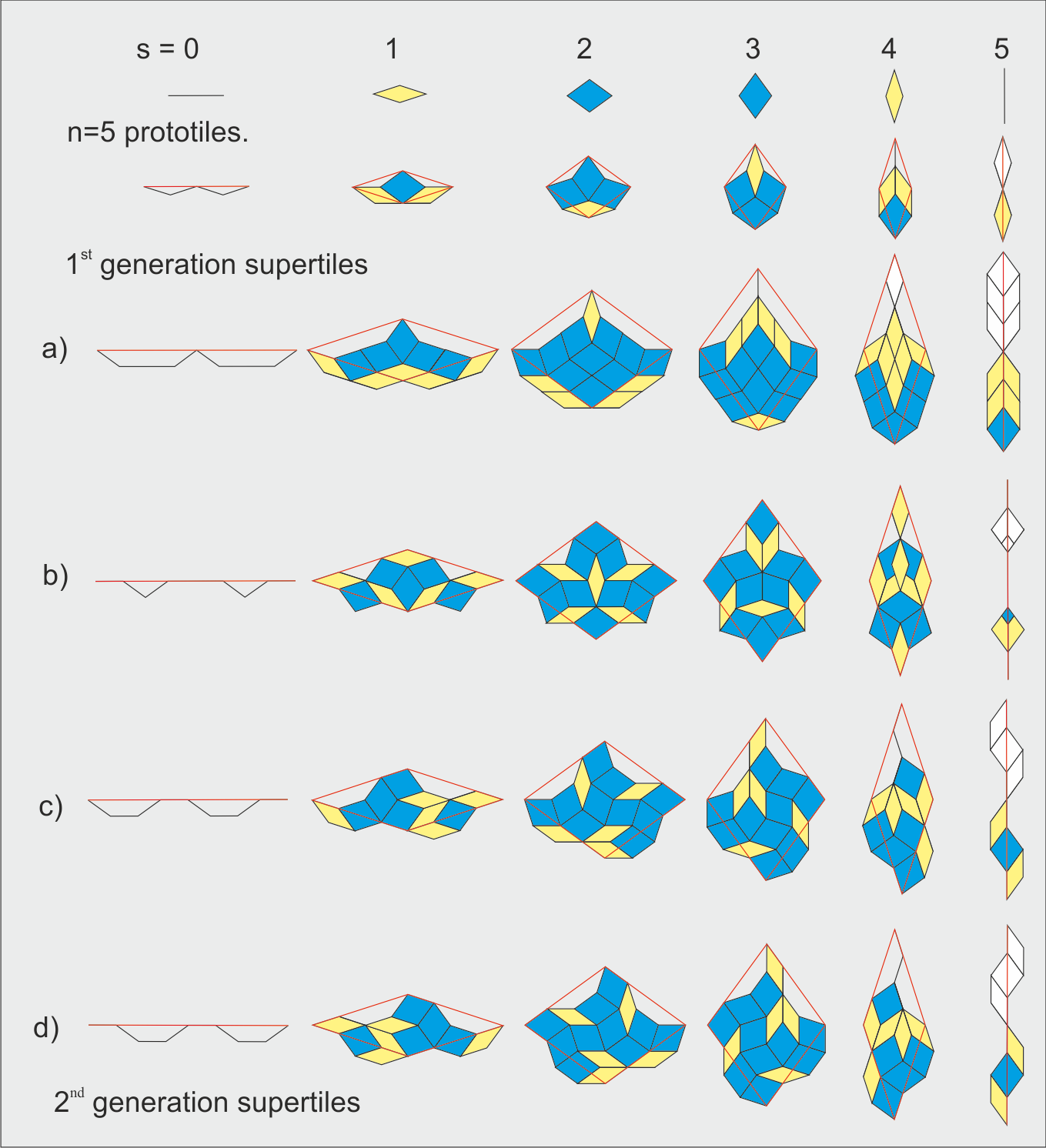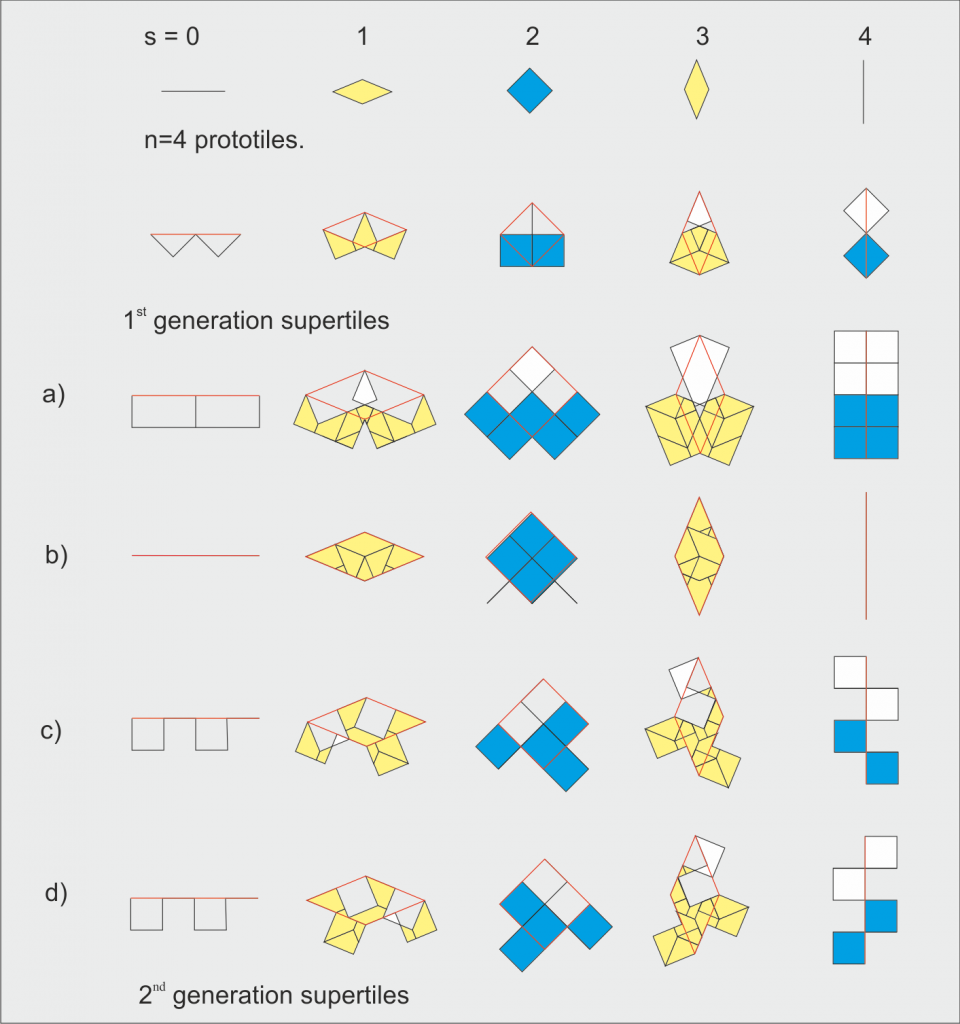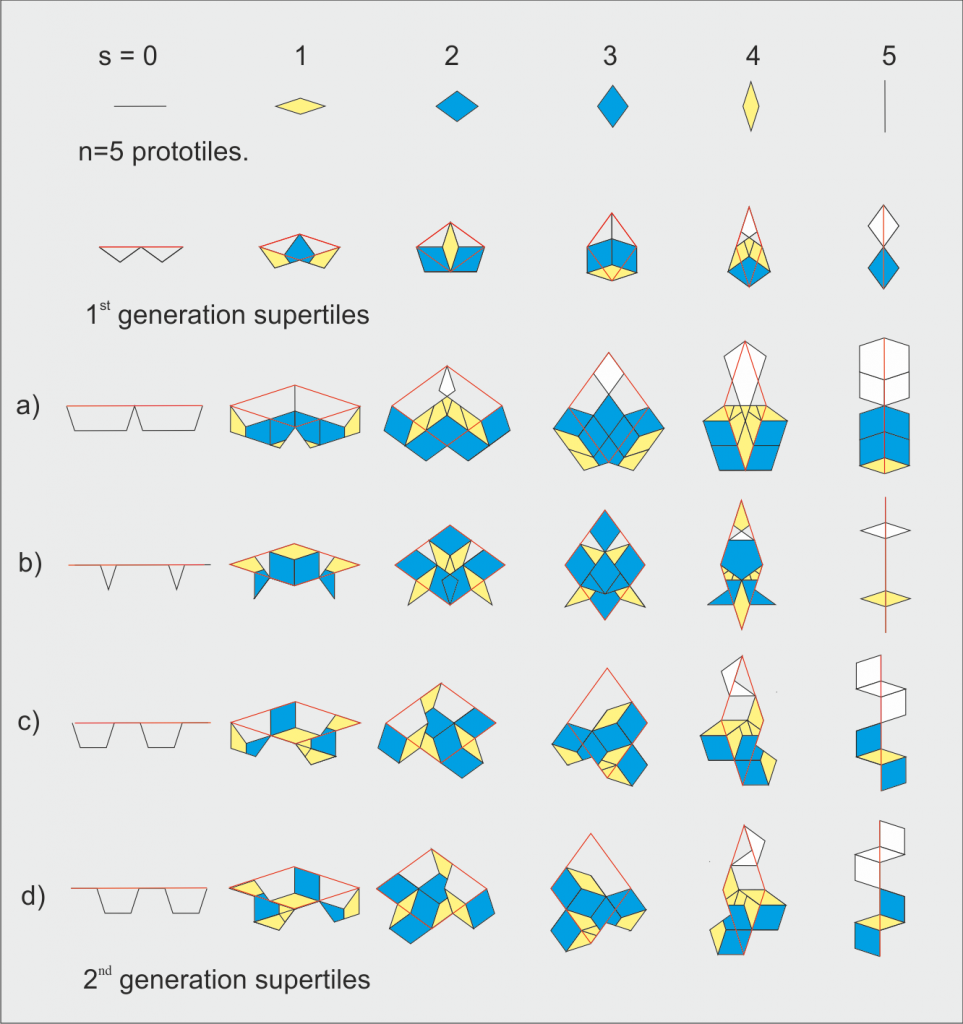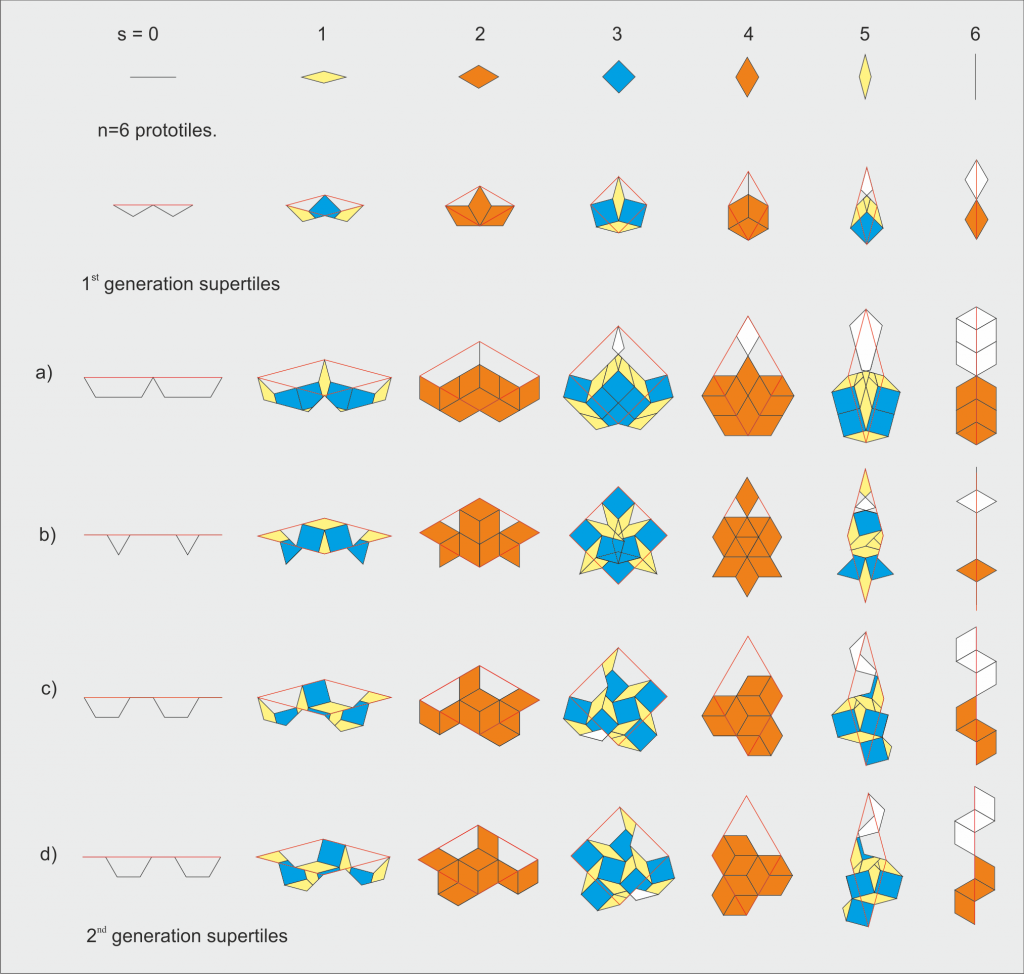A. 2×2 integer edge sequence solution.
The smallest first generation supertile is one based on either the ![]() or the (
or the (![]() ,
, ![]() ) edge sequence. In fact, the latter may be considered to be a special case of the first and will be discussed later. The
) edge sequence. In fact, the latter may be considered to be a special case of the first and will be discussed later. The ![]() edge sequence means that there is only one
edge sequence means that there is only one ![]() pair of edge angles, or
pair of edge angles, or ![]() . It follows that
. It follows that ![]() and
and ![]() , i.e. the supertile
, i.e. the supertile ![]() has to be constructed from the set of prototiles {
has to be constructed from the set of prototiles {![]() ,
,![]() ,
, ![]() }. In our general model the arrangement of the tiles is given by the supertile matrix
}. In our general model the arrangement of the tiles is given by the supertile matrix
(1) ![]()
In order to tile the plane, the inflation factor should be larger than one. Because ![]() ,
, ![]() should be larger than three. Below, supertiles are shown for
should be larger than three. Below, supertiles are shown for ![]() and
and ![]() . Rhomb prototiles
. Rhomb prototiles ![]() and
and ![]() are identical objects, but supertiles
are identical objects, but supertiles ![]() and
and ![]() are not. The supertiles also loose the twofold rotation axis perpendicular to the plane of the prototiles. Consequently, after the first generation supertiles there are four different substitution rules for the next supertile generation, which we have denoted by a), b), c) and d). a) is the basic supertile, in b) the tiles of a) have been rotated over
are not. The supertiles also loose the twofold rotation axis perpendicular to the plane of the prototiles. Consequently, after the first generation supertiles there are four different substitution rules for the next supertile generation, which we have denoted by a), b), c) and d). a) is the basic supertile, in b) the tiles of a) have been rotated over ![]() , in c) the
, in c) the ![]() and
and ![]() tiles of case a) have been replaced by the
tiles of case a) have been replaced by the ![]() and the
and the ![]() tiles respectively, and in d) the tiles of case c) have been rotated over
tiles respectively, and in d) the tiles of case c) have been rotated over ![]() . In matrix notation:
. In matrix notation:
(2) 
Underlined entries denote prototiles rotated over ![]() .
.
Fig. S1-S3 Substitution tiles for ![]() .
.
The supertiles consist only of single positive and negative parts, i.e. the tile overlaps which arise during the tiling proces are exactly compensated by negative tiles or tile parts. The first generation supertiles consist of two prototiles ![]() , one rotated over
, one rotated over ![]() and the other over
and the other over ![]() and a
and a ![]() and
and ![]() prototiles in the original position as drawn in the pictures. Negative tiles play a part for
prototiles in the original position as drawn in the pictures. Negative tiles play a part for ![]() and
and ![]() . For
. For ![]() the
the ![]() negative tile cuts of pieces of the other three tiles, as is illustrated in the picture for
negative tile cuts of pieces of the other three tiles, as is illustrated in the picture for ![]() below. For the
below. For the ![]() supertile, on the other hand, the two
supertile, on the other hand, the two ![]() prototiles partly overlap. This overlap is removed by the
prototiles partly overlap. This overlap is removed by the ![]() prototile. The
prototile. The ![]() supertile is just a zigzag line because the
supertile is just a zigzag line because the ![]() annihilates the
annihilates the ![]() tile. This is best seen by starting with
tile. This is best seen by starting with ![]() ,
, ![]() and
and ![]() prototiles,
prototiles, ![]() being a small value approaching zero. The negative
being a small value approaching zero. The negative ![]() and the positive
and the positive ![]() prototile do not overlap in the
prototile do not overlap in the ![]() supertile, although the total area is zero as it should.
supertile, although the total area is zero as it should.

B. 2×2 half-integer edge sequence solution.
Looking at the first three figures it becomes clear that for substitution rules a) and b) there are two independent prototile sets for even and odd s. This is also true for substitution rules c) and d) if ![]() is even. In fact, the half-integer edge sequence solution is identical to the integer edge sequence solution for a doubled
is even. In fact, the half-integer edge sequence solution is identical to the integer edge sequence solution for a doubled ![]() -value and even
-value and even ![]() . We will discuss these solutions in more detail below.
. We will discuss these solutions in more detail below.
The (![]() ,
, ![]() ) edge sequence means that
) edge sequence means that ![]() . It follows that
. It follows that ![]() and
and ![]() , i.e. the supertile
, i.e. the supertile ![]() has to be constructed from the set of prototiles {
has to be constructed from the set of prototiles {![]() ,
,![]() ,
, ![]() }. In our general model the arrangement of the tiles is given by the supertile matrix
}. In our general model the arrangement of the tiles is given by the supertile matrix
(3) ![]()
Below the first two generations of ![]() supertiles for
supertiles for ![]() with a halfinteger edge sequence are shown. If one compares these tiles with the integer case it is clear that negative tiles play a smaller role. Only for substitution rule a) a negative part appears in the
with a halfinteger edge sequence are shown. If one compares these tiles with the integer case it is clear that negative tiles play a smaller role. Only for substitution rule a) a negative part appears in the ![]() tile. For substitution rule c) and d) the tiles are not even cut up. The only tile having a negative part is the
tile. For substitution rule c) and d) the tiles are not even cut up. The only tile having a negative part is the ![]() tile. This tile is only involved in the construction of next generation
tile. This tile is only involved in the construction of next generation ![]() and
and ![]() tiles. In the latter case, its role is to move a patch of complete tiles from one end of the supertile to another, also for higher generations.
tiles. In the latter case, its role is to move a patch of complete tiles from one end of the supertile to another, also for higher generations.

The tilings resulting from the application of substitution rules a), b) and c) will be called:
a) Basic (1, -1) rhomb tiling, ![]()
b) Koch (1, -1) rhomb tiling,  . The supertile edges are related to the so called Koch curves.
. The supertile edges are related to the so called Koch curves.
c) Lancon Billard (1,-1) rhomb tiling, ![]() and its mirror image
and its mirror image  . For
. For ![]() the even s first generation substitution tiles are the Lancon Billard substitution tiles.
the even s first generation substitution tiles are the Lancon Billard substitution tiles.
Larger supertiles for all three cases are shown on a separate page called Large Supertiles. Special pages have been devoted to the Koch Supertiles and the Lancon Billard Supertiles.


